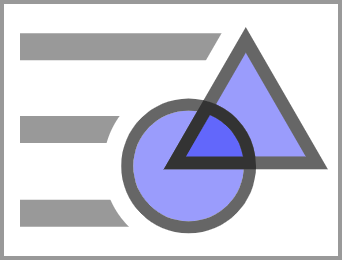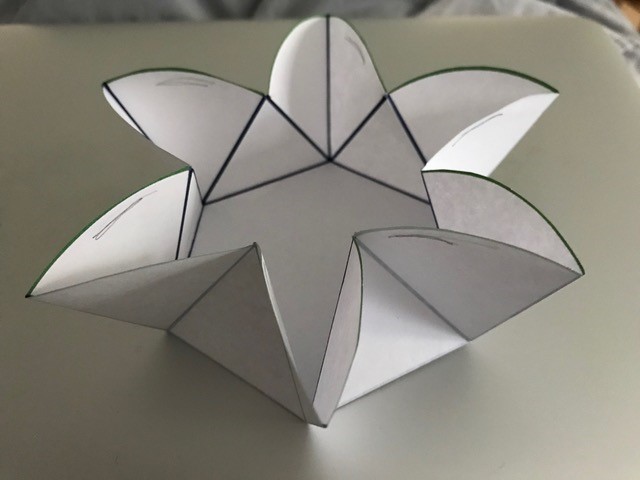Lesson 4
Construction Techniques 2: Equilateral Triangles
4.1: Notice and Wonder: Circles Circles Circles (5 minutes)
Warm-up
This is the first Notice and Wonder activity in the course. Students are shown a geometric construction composed of seven circles. The prompt to students is: “What do you notice? What do you wonder?”. Students are given a few minutes to write down things they notice and things they wonder. After students have had a chance to write down their responses, ask several students to share things they noticed and things they wondered; record these for all to see. Often, the goal is to steer the conversation to wondering about something mathematical that the class is about to focus on. The purpose is to make a mathematical task accessible to all students with these two approachable questions. By thinking about them and responding, students gain entry into the context and might have their curiosity piqued.
The purpose of this warm-up is to elicit the idea that many shapes can emerge within the regular hexagon construction, which will be useful when students reason about other shapes and construct equilateral triangles in a later activity. While students may notice and wonder many things about this image, naming the polygons that students could draw is the important discussion point.
This warm-up prompts students to make sense of a problem before solving it by familiarizing themselves with a context and the mathematics that might be involved (MP1).
Launch
Display the image for all to see. Ask students to think of at least one thing they notice and at least one thing they wonder. Give students 1 minute of quiet think time, and then 1 minute to discuss the things they notice and wonder with their partner, followed by a whole-class discussion.
Student Facing
What do you notice? What do you wonder?

Student Response
For access, consult one of our IM Certified Partners.
Activity Synthesis
Ask students to share the things they noticed and wondered. Record and display their responses for all to see. If possible, record the relevant reasoning on or near the image. After all responses have been recorded without commentary or editing, ask students, “Is there anything on this list that you are wondering about now?”.
Encourage students to respectfully disagree, ask for clarification, or point out contradicting information. If connecting intersection points to make polygons does not come up during the conversation, ask students to discuss this idea.
4.2: What Polygons Can You Find? (15 minutes)
Activity
The purpose of this activity is to get students thinking about what other shapes are possible within the regular hexagon construction. This leads into the next activity about constructing an equilateral triangle.
Identify students who find various shapes to share during discussion. For example, right triangles, equilateral triangles of various sizes, rhombi, parallelograms, rectangles, isosceles trapezoids, regular hexagons, and others. Also monitor for students whose conjectures only involve claims about distance. These are the most appropriate conjectures to justify during discussion, because all the circles have the same radius.
Launch
Display an image of a hexagon inscribed in a circle for all to see.

Remind students that they constructed a regular hexagon inside a circle in a previous lesson. Explain that when a shape fits inside a circle and every vertex of the polygon is on the circle, we say the shape is inscribed in the circle. Tell students that the word inscribe breaks into parts in, meaning inside, and scribe, meaning drawn or written, and so the word literally means drawn inside.
Supports accessibility for: Language; Organization
Student Facing
Here is a straightedge and compass construction of a regular hexagon inscribed in a circle just before the last step of drawing the sides:
-
Use the polygon tool (the one that looks like a triangle) to draw at least 2 polygons on the figure. The vertices of your polygon should be intersection points in the figure. Shade in your polygons using different colors to make them easier to see. Use the style bar to change the color. This is what the style bar looks like.

-
Write at least 2 conjectures about the polygons you made.
Student Response
For access, consult one of our IM Certified Partners.
Launch
Display an image of a hexagon inscribed in a circle for all to see.

Remind students that they constructed a regular hexagon inside of a circle in a previous lesson. Explain that when a shape fits inside a circle and every vertex of the polygon is on the circle, we say the shape is inscribed in the circle. Tell students that the word inscribe breaks into parts in, meaning inside, and scribe, meaning drawn or written, and so the word literally means drawn inside.
Action and Expression: Develop Expression and Communication. Invite students to talk about their ideas with a partner before writing them down. Display sentence frames to support students when they explain their ideas. For example, “I notice that _____,” “I know _____ because _____,” and “That could/couldn’t be true because....”
Supports accessibility for: Language; Organization
Student Facing
Here is a straightedge and compass construction of a regular hexagon inscribed in a circle just before the last step of drawing the sides:

- Use a straightedge to draw at least 2 polygons on the figure. The vertices of your polygon should be intersection points in the figure. Lightly shade in your polygons using different colored pencils to make them easier to see.
- Write at least 2 conjectures about the polygons you made.
Student Response
For access, consult one of our IM Certified Partners.
Anticipated Misconceptions
Some students may focus only on polygons whose vertices are marked on the diagram. Prompt them to look for other points of intersection that could be used as vertices.
Activity Synthesis
The purpose of this discussion is to illustrate that many conjectures, even if they appear obvious, are difficult to justify with only the information that all the circles have the same radius. Display several student responses for all to see to emphasize the vast possibilities this simple construction allows.
Here are some questions for discussion:
- “Are all the circles the same size?” (Yes. Connecting the centers of any pair of adjacent circles shows they have the same radius. Comparing successive pairs shows that they all have the same length of radius.)
- “For which of these conjectures can we give a convincing explanation as to why it’s true?”
- “For which of these conjectures do we not know enough about yet to explain?”
If need be based on the pre-unit diagnostic, use the various shapes students generated to review vocabulary.
- “What is it called when a triangle has two congruent sides?” (Isosceles triangle.)
- “What is the quadrilateral that has two parallel sides called? And what if two of its sides are congruent?” (Trapezoid. Isosceles trapezoid.)
- “What is the quadrilateral with two pairs of parallel sides called? What if all 4 of its sides are congruent?” (Parallelogram. Rhombus.)
4.3: Spot the Equilaterals (15 minutes)
Activity
The purpose of this activity is for students to compare the possible ways of constructing equilateral triangles. Look for student work that illustrates a variety of methods and sizes of triangles.
Making dynamic geometry software available gives students an opportunity to choose appropriate tools strategically (MP5).
Launch
Encourage students to construct the equilateral triangles using different methods rather than repeating the same method twice.
Student Facing
Use straightedge and compass moves to construct at least 2 equilateral triangles of different sizes.
Student Response
For access, consult one of our IM Certified Partners.
Student Facing
Are you ready for more?


- Examine the figure carefully. What different shapes is it composed of? Be specific.
- Figure out how to construct the figure with a compass and straightedge.
- Then, cut it out, and see if you can fold it up into a container like this.
Student Response
For access, consult one of our IM Certified Partners.
Anticipated Misconceptions
If students get stuck, ask them to refer to the warm-up to see whether they can spot equilateral triangles. Then encourage them to do the compass and straightedge moves required to make those equilateral triangles.
Activity Synthesis
Display several student responses for all to see. Ask students to explain their methods for producing equilateral triangles and justify how they know each triangle is equilateral. If not mentioned by students, conjecture that, in some of these constructions, the entire construction remains the same even when rotated \(\frac13\) of a full turn (120 degrees) around the center. This means that each side can be rotated onto the other sides, and each angle can be rotated onto the other angles. This plants ideas about symmetry that will be explored in later lessons.
Design Principle(s): Support sense-making; Cultivate conversation
Supports accessibility for: Language; Organization
Lesson Synthesis
Lesson Synthesis
Display the image from the warm-up again for all to see. Ask students whether there are any shapes they are able to find now that they didn’t notice at the beginning of the lesson. Ask a few students to display their responses. Invite students to make conjectures about their shape and to justify their claims.
4.4: Cool-down - I’m Stuck In A Circle! Help! (5 minutes)
Cool-Down
For access, consult one of our IM Certified Partners.
Student Lesson Summary
Student Facing
The straightedge allows us to construct lines and line segments, and the compass allows us to make circles with a specific radius. With these tools, we can reason about distances to explain why certain shapes have certain properties. For example, when we construct a regular hexagon using circles of the same radius, we know all the sides have the same length because all the circles are the same size. The hexagon is called inscribed because it fits inside the circle and every vertex of the hexagon is on the circle.
Similarly, we could use the same construction to make an inscribed triangle. If we connect every other point around the center circle, it forms an equilateral triangle. We can conjecture that this triangle has 3 congruent sides and 3 congruent angles because the entire construction seems to stay exactly the same whenever it is rotated \(\frac{1}{3}\) of a full turn around the center.
